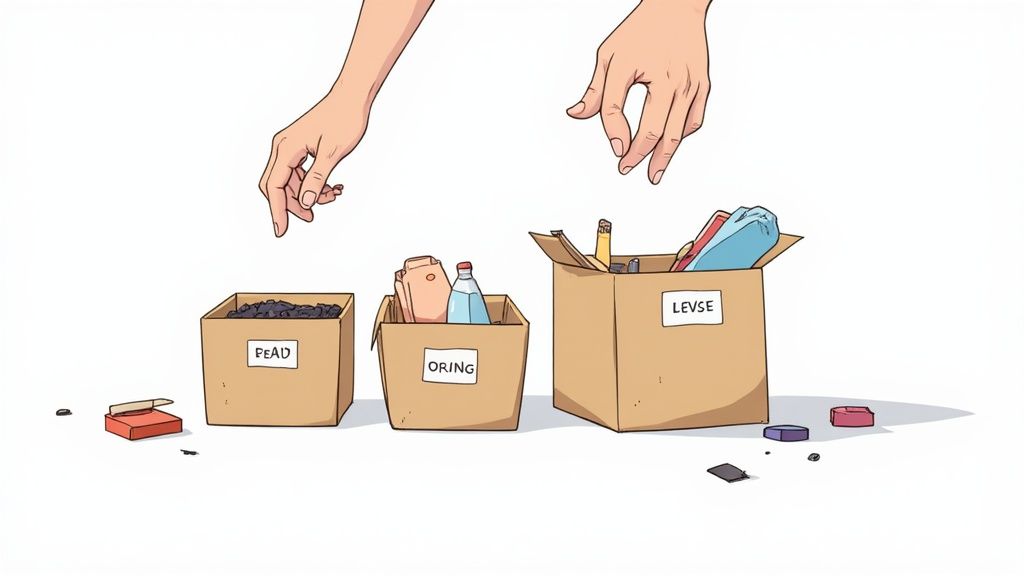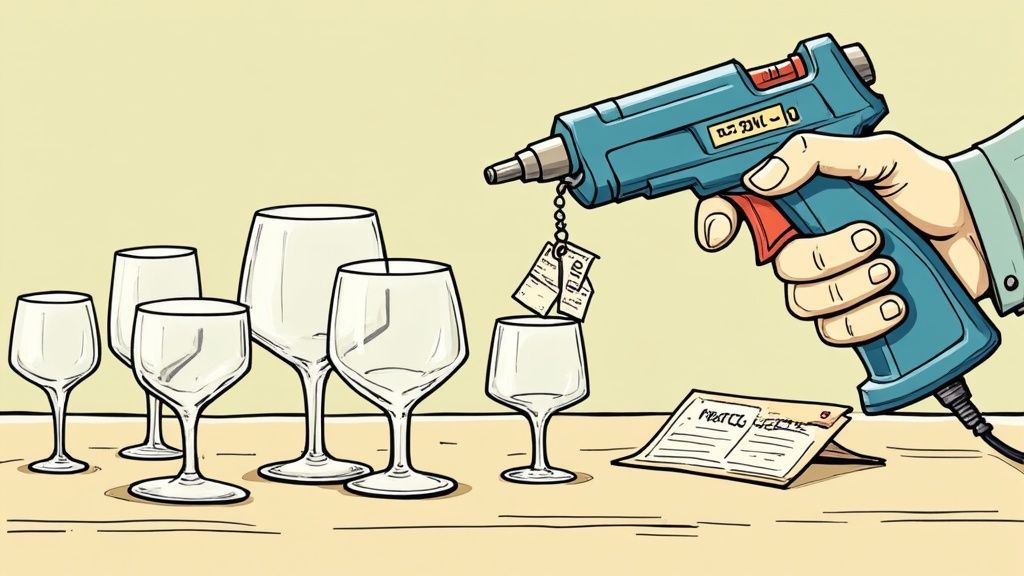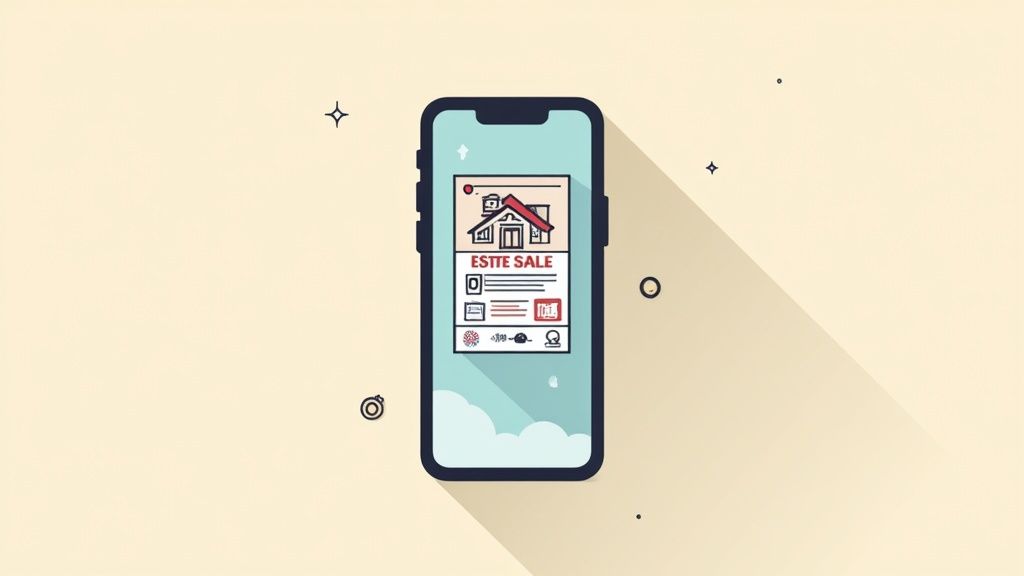So, you’re facing the task of running an estate sale. It can feel like a mountain of a project, but breaking it down into a clear, manageable plan is the secret to success. It’s all about turning a potentially overwhelming job into a series of logical steps, from the initial decisions right through to the final cleanup.
Building Your Estate Sale Game Plan
Before you even think about putting a price tag on a single teacup, you need a solid game plan. This is where you lay the groundwork for a smooth, profitable event. Skipping this step is where things often go sideways, leading to stress and lost money. It’s about making a few key decisions upfront, understanding your responsibilities, and getting ready for the work ahead.
It’s no surprise that estate sales are closely tied to the real estate market. When homes change hands, the contents often need to be liquidated. We see this in broader market trends—even with a shaky economy, residential house prices have been climbing at a steady clip, often around 3.3 to 3.6 percent each quarter in major areas. As more homes sell, the need for well-run estate sales goes right up with it.
The First Big Decision: DIY or Professional Help?
Your first, and arguably most important, decision is whether to tackle this yourself or bring in a professional company.
Going the DIY route gives you total control. You don't have to pay a commission—which can be a hefty 35% to 50% of the total sales—and you make all the final calls. The flip side is that you are responsible for everything. We’re talking about every single detail, from sorting through dusty boxes and pricing thousands of items to advertising the sale and managing the crowds on the day.
Hiring an estate sale company means you’re outsourcing all that intense labor. You get to lean on their experience with pricing, their marketing know-how, and their ability to handle a flood of shoppers. Professionals almost always have a built-in network of loyal buyers and a much better sense of what items are actually worth, which can lead to a much higher grand total.
Expert Insight: Honestly, the choice between DIY and hiring a pro comes down to your available time, energy, and what’s in the house. If you're dealing with a smaller home filled with standard household goods, a DIY sale can work out great. But if the estate is packed with valuable antiques, art, or niche collectibles, a professional team will almost always earn you more money, even after their commission.
DIY vs Professional Estate Sale Company
Deciding how to manage the sale is a major fork in the road. This table breaks down what each path looks like so you can see which one aligns better with your situation.
| Factor | DIY Approach | Professional Company |
|---|---|---|
| Control | You have 100% control over every decision, from pricing to which items are sold. | You cede most control. The company handles pricing, staging, and sale execution based on their expertise. |
| Costs | No commission fees. Costs are limited to supplies, marketing, and your time. | Commission-based, typically 35-50% of gross sales. Some may have minimums or flat fees. |
| Labor & Time | Extremely time-consuming. You are responsible for all sorting, research, pricing, staging, and staffing. | They handle all the labor. Your time commitment is minimal after the initial consultation. |
| Expertise | Relies on your own knowledge. Risk of under-pricing valuables or over-pricing common items. | Access to experienced appraisers, researchers, and a team that knows current market values. |
| Marketing | You manage all advertising—signs, online listings, social media, etc. Reach may be limited. | Professionals have established marketing channels and a large following of regular buyers and dealers. |
| Outcome | Potentially higher net profit on smaller sales, but a huge investment of personal time and energy. | Often higher gross sales. Lower net after commission, but with significantly less stress and work. |
Ultimately, there's no single "right" answer. A realistic assessment of the estate's contents and your own capacity is the best way to choose.
Establishing Your Timeline and Goals
One of the biggest mistakes people make is underestimating how long this all takes. If you try to rush it, you’ll end up with sloppy pricing, you might accidentally sell a valuable item for pennies, and you’ll burn yourself out.
For a typical home, you should give yourself a solid 2 to 4 weeks from start to finish. If you’re dealing with a larger or more complicated estate, it could easily take six weeks or more. To see what that timeline looks like in detail, our step-by-step guide on how to prepare for an estate sale has a fantastic checklist.
Here’s a simple way to break it down:
- Week 1: Do the initial walkthrough. Decide if you’re going DIY or hiring a pro. Set your main goals.
- Weeks 2-3: This is the heart of the project. You'll be sorting, decluttering, researching, and pricing everything.
- Week 4: Time for the final push! This is when you stage the house to look like a retail shop, launch your marketing, and get ready for sale day.
Setting clear goals is just as crucial. What’s your number one priority? Is it to squeeze every last dollar out of the contents? Or is the main goal to empty the house as fast as possible for a real estate closing? Maybe it's a mix of both. Knowing your primary objective from the get-go will make every other decision that much easier.
The Hands-On Work: Sorting and Decluttering the Right Way

This is where the boots hit the ground. You're about to turn a home filled with a lifetime of memories and possessions into a space that’s ready for a sale. The sheer volume can feel overwhelming, and it's easy to get sidetracked by emotion. The secret? A system. You have to tackle it methodically, one room at a time.
I’ve found the most foolproof strategy is what we call the four-box method. For every single item you pick up, you make an immediate decision and put it into one of four spots: Keep, Sell, Donate, or Discard. This forces you to be decisive and prevents the classic mistake of just moving piles around.
My Golden Rule: Touch every item just once. Make a decision on the spot. This one habit is a game-changer. It cuts down on wasted hours and stops the decision fatigue that can bring the whole process to a screeching halt.
Putting the Four-Box System into Action
Don't try to tackle the whole house at once. That's a recipe for burnout. Start small to build some momentum—a guest bathroom or a hall closet is perfect. Get your supplies ready: boxes, heavy-duty trash bags, and a good marker. The goal is progress, not perfection.
- Keep: These are the non-negotiables—items the family has already claimed. Get them out of the house or into a locked, clearly marked room immediately. You don't want a priceless heirloom accidentally sold for a dollar.
- Sell: This is for anything you think has resale value. Don't get hung up on pricing at this stage. Just focus on separating what's going into the sale.
- Donate: These are items that are still in good shape but probably won't fetch much money. Think everyday clothes, basic kitchen dishes, or paperback books. They can still do some good for someone else.
- Discard: Be ruthless here. This is for anything broken, stained, expired, or just plain junk. Remember, hauling away trash costs both time and money, so it’s better to deal with it now.
This disciplined sorting turns what feels like an emotional marathon into a series of manageable sprints. Room by room, you’ll see the clutter recede and order emerge.
Dealing with Personal Effects and Hidden Gems
As you sort, you’re guaranteed to come across very personal things—photo albums, bank statements, old letters, and diaries. These should never be left out in the open. Have a dedicated, secure box for all personal papers and keepsakes. This needs to be set aside for the family to review privately later on.
At the same time, keep your eyes peeled for unexpected treasures. It’s shocking how often valuable items are mistaken for junk. You're not just sorting; you're on a treasure hunt.
Don't Overlook These Common Valuables
| Category | What to Look For |
|---|---|
| Kitchenware | Cast iron pans (especially Griswold or Wagner), vintage Pyrex with unique patterns, and old colored canning jars. |
| Ephemera | Old postcards with stamps, concert ticket stubs from famous bands, vintage advertising signs, and old high school yearbooks. |
| Costume Jewelry | Unsigned but well-crafted pieces, Bakelite bracelets, and sparkly old rhinestone brooches can be surprisingly valuable. |
| Tools & Garage Items | Old hand tools from quality brands (Snap-on, vintage Craftsman), and antique wooden fishing lures. |
These little finds can really add up, sometimes adding hundreds or even thousands to the sale’s total. When you approach sorting with this dual focus—being sensitive to personal history while also having a sharp eye for value—you're laying the perfect groundwork for a successful sale.
How to Price and Stage for Maximum Profit

Alright, you've sorted through a lifetime of possessions. Now comes the part where strategy and psychology really come into play: pricing and staging. This is where you turn piles of stuff into actual profit. Get it right, and you'll have a successful sale. Get it wrong, and you'll be left with a house full of tagged items and a lot of frustration.
Staging a home for an estate sale isn't like staging it for a real estate showing. Forget minimalism. Your job is to create a shoppable, browsable environment that feels more like a unique boutique than a cluttered house.
Smart Pricing Strategies
When it comes to pricing, your gut can be your worst enemy. If you just guess, you're either going to price things too high and watch shoppers walk away empty-handed, or price too low and leave a ton of money on the table. Finding that sweet spot requires a little bit of homework.
For common household goods—think kitchenware, decor, and linens—a solid starting point is 10% to 20% of what they cost brand new. But that's just a guideline. For the more interesting stuff like quality furniture, vintage collectibles, or electronics, you need to do some digging.
Your best friend here is the "sold" filter on eBay. It shows you what people are actually paying for an item, not just what sellers are asking. For a much deeper look into getting this just right, we've put together a comprehensive guide on how to price estate sale items that walks you through the specifics.
Expert Tip: Plan your discounts from the start. A multi-day sale works best with a tiered markdown schedule. Maybe everything is full price on Friday, 25% off on Saturday morning, and then 50% off for the final hours on Sunday. This builds urgency and helps you clear everything out.
Don't forget the power of bundling. Got a drawer full of cooking utensils? Bag them up and sell the whole lot for $5. A box of children's books? Price it at $10. This helps move small, low-value items that might otherwise be ignored and increases how much each customer spends.
Staging That Sells
Once your price tags are on, it's time to set the stage. The goal here is simple: make it easy and enjoyable for people to shop. A chaotic, messy sale is overwhelming and will send buyers heading for the door.
Create Obvious Pathways: People need to be able to move around freely. Make sure hallways and rooms have enough space for at least two people to pass by each other without bumping. If someone feels trapped, they won’t stick around to browse.
Group Like with Like: Organize the house like a department store. All the kitchen stuff goes in the kitchen. All the tools belong in the garage or basement. Linens and clothing can be consolidated in the bedrooms. This logical flow helps shoppers find exactly what they're looking for without having to hunt.
Let There Be Light: A well-lit space makes everything look cleaner and more appealing. Throw open every curtain and flip on every light switch. If you have a showcase item—a beautiful piece of art, a jewelry display—shine a small, dedicated lamp on it to draw the eye.
Get Things Off the Floor: Display your items with respect. Use tables, bookcases, and any available flat surface to get merchandise up to eye level. It makes the sale feel more professional and prevents your valuable items from getting stepped on or overlooked.
Marketing Your Sale to Attract Eager Buyers

You’ve sorted, staged, and priced everything. Now for the fun part: getting the word out. An estate sale is worthless without a crowd of enthusiastic buyers, and effective marketing is how you create that buzz. Your goal is to cast a wide net, pulling in everyone from the serious collector who arrives an hour early to the casual neighbor just looking for a bargain.
Don’t wait until the last minute. You should start promoting your sale at least one week in advance. This gives people plenty of time to see your ads, mark their calendars, and get excited about the treasures you're offering. I’ve found the most success by combining a strong online push with good old-fashioned, on-the-ground signage.
Getting the Word Out Online
These days, the vast majority of shoppers find sales through the internet. The trick is to be strategic and post where they are already looking.
- Estate Sale Websites: This is non-negotiable for a serious sale. Sites like EstateSales.net and EstateSales.org are the industry leaders. For a small fee, your listing gets pushed out to thousands of dedicated followers who get email alerts for local sales. It's the best money you'll spend on marketing.
- Facebook Marketplace: A fantastic free tool with a massive local audience. Post your sale in the “Garage & Moving Sales” section. Also, find and post in local community and buy/sell groups—this is where you’ll find a lot of your neighborhood traffic.
- Craigslist: It might feel a bit old-school, but the "Garage & Moving Sales" section on Craigslist is still a regular stop for many longtime sale-goers. It’s free and hits a slightly different crowd than Facebook, so it's worth the five minutes it takes to post.
Your online ad is your digital storefront. Make it compelling! Use a headline that grabs attention by mentioning your best categories, like: "Packed Estate Sale: Mid-Century Furniture, Vintage Pyrex & Power Tools!"
In the ad itself, list the dates, times, and full address. But the most important part? Photos. Lots of clear, well-lit photos. A shot of a sought-after vinyl record or a unique piece of art is infinitely more powerful than a blurry picture of a packed room. Show off the good stuff!
Don't Forget About Signs
Never, ever underestimate the power of a simple, well-placed sign. Bright, easy-to-read signs are your secret weapon for catching drive-by traffic and guiding people right to your front door.
My Tried-and-True Sign Method: Keep it simple. Use a thick black marker on a neon poster board. All you need are three things: "ESTATE SALE," the address, and a big, bold arrow. That’s it. Place them at the nearest major intersections and at every single turn someone would need to make to find the house.
Tapping into what modern buyers want is key. People aren't just looking for deals; they're embracing the sustainable, unique nature of buying second-hand. You're not just liquidating items; you're offering a curated experience for people who value history and good design. By marketing your sale well, you're connecting with this growing movement. You can learn more about 2025 estate sale trends on AcadianaGold.com.
Managing Sale Days and Post-Sale Logistics

This is it—the moment all your hard work and preparation lead up to. The success of your sale days hinges on how well you execute, and this is where your careful planning will really pay off. A smooth, profitable event is all about managing people, payments, and the property with confidence and a clear head.
First things first: you can't do this alone. Trying to be a hero and run a busy sale by yourself is a recipe for disaster. For a typical house sale, you'll want a team of at least two or three people. One person should be dedicated to the checkout station, while one or two others can "float" through the home to answer questions, straighten up displays, and generally keep an eye on everything.
Running a Smooth and Secure Sale
A well-run sale has a great energy—it feels busy and exciting, but always under control. The trick is to create an environment that's both secure and efficient, making it as easy as possible for shoppers to find what they want and buy it.
Think of your checkout station as command central. It needs to be set up near the main exit, ideally with a clear view of the front door. Make sure you have a cash box with plenty of change; I always start with at least $100 in a mix of bills and coins. These days, you absolutely must be ready to take digital payments. Services like Venmo or Square are essential, as many buyers rarely carry cash.
Security and safety are paramount. You can't be too careful.
- Control the Flow: Be prepared for a line on the first morning. Don't just open the doors and let everyone flood in. Let people in small, manageable groups of 10-15 at a time to prevent a mad rush that could lead to broken items or theft.
- Secure Valuables: Small, high-value items like jewelry, watches, or rare collectibles should be kept behind the checkout counter or inside a locked display case where they can be closely monitored.
- Create a "Sold" Area: Designate a specific spot, maybe a garage or a corner of the living room, for large items that have been sold. Immediately attach a sold tag with the buyer's name and agreed-upon pickup time to prevent any mix-ups.
A Pro's Perspective: Be crystal clear about your policy for large items. Buyers are always responsible for their own moving and loading. State this on your signs, in your ads, and again at checkout. The last thing you want is to be asked to help lift a heavy armoire—that’s a huge liability risk you don’t want to take.
Handling Post-Sale Clean-Up
Once the final shopper has left, you can take a breath, but the job isn't quite finished. The last phase is the clean-up, and you need a decisive plan for every single item that didn't sell. The goal is to leave the property completely empty and clean, a condition often called "broom swept" in the industry. For a complete rundown of the entire process, our guide on how to organize an estate sale is a great resource.
You generally have three options for what's left over:
- Donation Pickup: Many charities, like Goodwill or The Salvation Army, offer free pickup services for large donations. The key is to schedule this in advance for the day right after your sale concludes.
- Buyout Service: Professional buyout companies will make you a cash offer for all remaining contents. You'll get less money than you would have selling things piece by piece, but they clear everything out for you. The convenience is often worth it.
- Junk Removal: For the items that are broken, unsellable, or can't be donated, a junk hauler is your final step to get the property completely cleared.
By deciding on your clean-up strategy before the sale even starts, you guarantee a swift, stress-free conclusion to your project. This foresight is what separates the amateurs from the pros.
Common Questions About Estate Sale Organization
When you're facing an estate sale, a flood of questions is completely normal, especially if this is your first time. Getting a handle on the key issues upfront helps you sidestep the common pitfalls that can eat up both time and money. Let's tackle some of the most frequent questions I hear from families just starting out.
How Long Does It Take to Organize an Estate Sale?
This is the big "how long" question, and the honest answer is: it depends. The size of the home and the sheer volume of stuff inside are the biggest factors. For a typical family home, I always recommend people budget a solid 2 to 4 weeks from start to finish. This gives you enough breathing room to manage each step without burning out.
So, what does that timeline look like in practice?
- Sorting & Pricing (1-2 weeks): This is where you'll spend most of your energy. You’re going through literally everything, deciding what to sell, keep, or toss, and then figuring out what it’s all worth.
- Marketing (1 week): You need to start getting the word out at least a week before the doors open. This builds excitement and ensures you have a crowd waiting on day one.
- The Sale (2-3 days): Most sales run over a weekend, usually kicking off on a Friday and ending Sunday.
If you're dealing with a larger property with barns, workshops, or extensive collections, don't be surprised if the prep work stretches to six weeks or even longer. Trying to cram it all into a shorter timeframe is a surefire way to make costly mistakes.
What Are the Biggest Mistakes to Avoid?
I’ve seen it all, and the most painful mistakes usually boil down to three things: bad pricing, weak marketing, and not being ready for the emotional toll.
Pricing is a huge one. If you price items too high, you'll be stuck with a house full of stuff at the end. Price too low, and you're leaving a significant amount of money on the table. It's a delicate balance.
Another classic error is thinking a sign in the yard is enough. It's not. To get the right kind of buyers—the ones who spend money—you need to market the sale effectively online and in local circles. Finally, please don't underestimate how emotionally draining this process can be. It's tough sorting through a lifetime of memories, so be kind to yourself.
A Word of Warning: One of the most heartbreaking mistakes is throwing away something valuable. That bag of old costume jewelry, those dusty books, or the rusty tools in the garage might be junk... or they could be worth hundreds. When in doubt, set it aside to research later. You’ll be glad you did.
Should I Have a Sale or Just Donate Everything?
This really comes down to a trade-off: time versus money.
If the house is filled with good-quality furniture, art, collectibles, and other desirable items, an estate sale is almost always the best way to maximize the financial return. It takes work, no doubt, but the payoff can be thousands of dollars.
On the other hand, if your main goal is just to empty the house fast—maybe you have a looming real estate closing—donating everything is a much quicker solution. It's also the practical choice if the contents are mostly everyday items with little resale value. You won't get cash, but you'll get the job done and a tax deduction for your trouble.
How Should I Handle Very Valuable Items?
If you stumble upon what you suspect is a truly high-value piece—fine art, a rare antique, or serious jewelry—a standard estate sale is probably not the right venue to get top dollar. These items need a different strategy.
Your first move should be to get a professional appraisal. An appraiser can give you a real-world valuation and point you toward the best sales channel. That might mean a specialized auction house, a reputable consignment store, or a private dealer who has a network of collectors.
Trying to sell these treasures on your own, without an expert opinion, is a massive gamble. It's how people accidentally sell a $10,000 painting for $100.
Feeling overwhelmed trying to figure out what’s valuable? This is exactly why we built Curio. Just snap a photo of any item, and our app instantly digs up its history, origin, and an estimated market value. It’s like having an appraiser in your pocket, giving you the confidence to price things right and spot the hidden gems.
Download it today and start turning mystery into profit. You can learn more and grab a free trial at https://www.curio.app.
